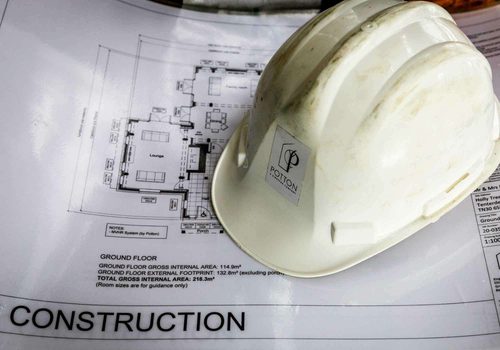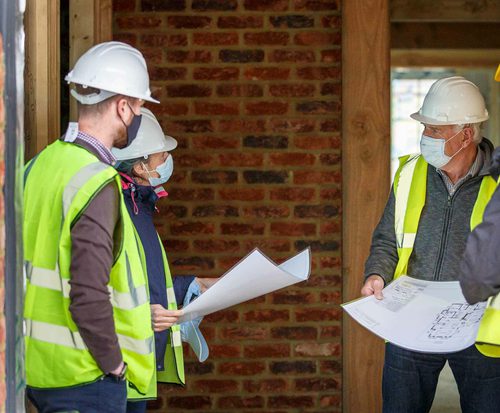The health & safety regulations relevant to construction are known as the CDM Regulations, which can seem daunting and confusing at first if you are starting your self build. We’ve tried to provide a simple explanation of the requirements needed, to make sure you have a safe, enjoyable, and successful build.
For all our Potton customers, you'll receive a comprehensive support package. Full of information and advice to build on the knowledge provided here.
What are the CDM regulations?
The primary set of regulations that govern health, safety and welfare for construction projects are The Construction (Design & Management) Regulations (CDM 2015). These affect all building and construction work, including new builds, refurbishment, conversions, extensions, demolition, maintenance, and repair.
Previous versions of the CDM exempted domestic clients, with many of these obligations only applying to other types of construction projects. However, this all changed in 2015. The exemption was removed and domestic client’s obligations were transferred to the contractor. Or principal contractor, where more than one contractor is working on a project.
The 2015 CDM regulations define domestic clients as, 'people who have construction work carried out on their own home, or the home of a family member that is not done as part of a business, whether for profit or not. If you are a self-builder then you are a domestic client.
On commercial builds, it is usually the client’s responsibility to notify the Health and Safety Executive (HSE) at the start of a project. For domestic clients, the responsibility lies with the contractor or principal contractor to submit the notification. You can easily notify the HSE on their website by filling in the HSE Notification of Construction Project form.
Self build projects that are less than 500 person days of work on site do not need to notify the HSE. Self build projects such as timber frame builds use off-site methods of construction. So with less days onsite, you may not need to notify the HSE if using this build system.
How do you appoint a principal contractor?
If there is more than one contractor, you as a client do not appoint a principal contractor and principal designer. These duties automatically fall to the designer and contractor in control of the pre-construction and construction phases.
If Potton is providing you with an architectural service, we automatically assume the responsibilities of the Principal Designer.
The CDM regulations aren’t intended to prevent self-builders from managing their own projects. Instead, they are designed to make sure that projects proceed in a safe and organised manner. The HSE expects individual contractors to advise the self-builder on any specialist matters within their work activities.
The expectation on you, as a self-builder, is on co-ordination rather than supervision of contractors on site. In other words, you’re entitled to expect contractors to plan, manage and monitor their own work.
The support and services that we provide at Potton are to ensure that you, as a self-builder, can manage your own build in a safe and effective way.
The regulations set out many requirements for work carried out on a construction site. Some of which are listed below. Contractors must comply with these and include provisions relating to them. They are not all applicable on every self build project. With several that are easy to address, as they are part of general good practice.
- An appropriate level of site welfare
- Safe places of construction work
- Good order and site security
- Stability of structures
- Demolition or dismantling
- Excavations
- Reports of inspections
- Traffic routes
- Vehicles
- Prevention of risk from fire, flooding or asphyxiation
- Emergency procedures
- Emergency routes and exits
- Fire detection and fire-fighting
- Temperature and weather protection
- Lighting
Who are the CDM duty holders?
The CDM 2015 creates a number of duty holders who must undertake specific actions. The table below sets out the role of duty holders as they relate to self build.
| CDM duty holders for self build - who are they? | Summary of role / main duties |
|---|---|
| Domestic Clients | |
| People who have construction work carried out on their own home, or the home of a family member, that is not done in furtherance of a business whether for profit or not. | Domestic clients are in scope of CDM 2015, but their duties as a client are normally transferred to:
|
| Principal Designers | |
| Designers appointed by the client in projects involving more than one contractor. They can be an organisation or an individual with sufficient knowledge, experience and ability to carry out the role. | Plan, manage, monitor and co-ordinate health and safety in the pre-construction phase of a project. This includes:
|
| Designers | |
| Those who, as part of a business, prepare or modify designs for a building, product or prepare or modify designs to systems relating to construction work. | When preparing or modifying designs, eliminate, reduce or control foreseeable risks that may arise during:
|
| Principal Contractors | |
| Contractors appointed by the client to co-ordinate the construction phase of a project where it involves more than one contractor. | Plan, manage, monitor and co-ordinate the construction phase of a project. This includes:
|
What is a construction phase plan?
For every project, the regulations require a client to ensure that a construction phase plan is drawn up. This should be done by the contractor or principal contractor before the construction phase begins. If you are self managing and acting as the project manager, then you will need to produce the construction phase plan yourself.
The construction phase plan records arrangements for managing significant health and safety risks associated with the construction of the project. It’s the basis for communicating those arrangements to anyone involved in the construction phase.
Pre-construction information provided by you, as the client, forms the basis of the construction phase plan. The plan must also take into account information the principal designer holds and any information obtained from designers.
During the course of the project, the principal contractor (or contractor) must make sure that the construction phase plan is reviewed, updated and revised. The plan should be easy to understand and be as simple as possible. Everyone on site, including visitors, must comply with the plan.
Here are some topics that should be considered while the plan is being drawn up:
- A description of the project. Including key dates and details of key members of the project team
- The management of the work including:
- The health and safety aims for the project
- The site rules
- Arrangements to ensure cooperation between project team members and coordination of their work, e.g. regular site meetings
- Arrangements for involving workers
- Site induction
- Welfare facilities
- Fire and emergency procedures
- The control of any of the specific site risks listed in Schedule 3 where they are relevant to the work involved
Don’t panic. Preparing a construction phase plan is easy to do
The Construction Industry Training Board has produced an easy to use free app that can be used to create construction phase plans in a manner of minutes. Just search ‘CDM Wizard app’ or visit www.citb.co.uk




